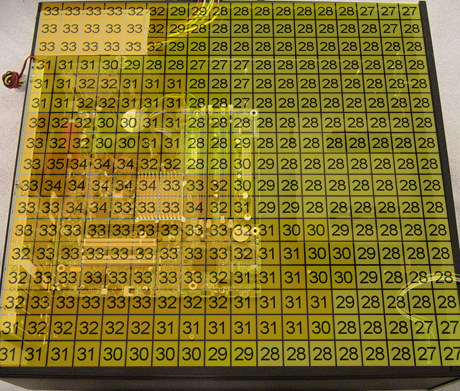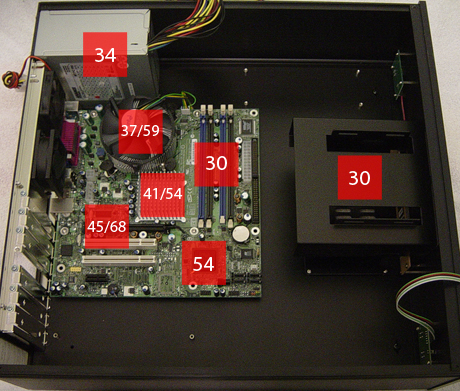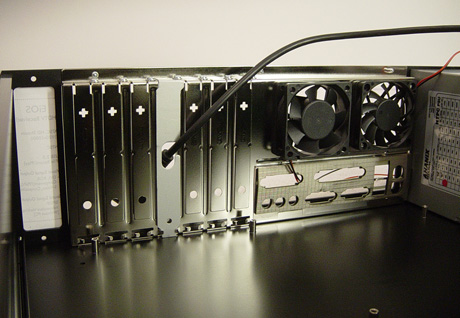Intel's Long Awaited BTX Form Factor
by Purav Sanghani on November 15, 2004 5:31 AM EST- Posted in
- Cases/Cooling/PSUs
Thermals Desktop ATX
We tested our D915GUX board and Pentium 550 CPU in Ahanix's D.Vine 5 HTPC chassis, the successor to the D.Vine 4 we reviewed last month, since it had the size of a typical mid tower case yet took on the form of a flat lying desktop case like the B300 to give a better idea of how this hardware performed in a case with sizes we are used to. Unlike Opus Technologies, Ahanix has a great deal of products, many of them cases which is their main focus. The first case we reviewed from Ahanix was their Black Knight. The Black Knight performed well in our thermal benchmarks while averaging at 50dBA in sound We again measure temperatures of the ambient air inch by inch to show how each component affects various areas of the case.
Click to Enlarge
It is evident that the warmest region in our desktop ATX system is between the CPU, Northbridge, and PCIe VGA card followed by the power supply. We also notice how the rear exhaust fans are pulling the warm air towards them to the outside. The D.Vine 5 has an extremely large footprint, 17" in width by 18" in depth, so there are many areas which are not being exposed to warm air such as the front corners as well as the left side of the case.

Click to Enlarge
We see here that the CPU, Northbridge heatsink and the PCIe VGA card are the hottest components in the system. The Southbridge also ran extremely hot at 54 degrees, but it is too small to have as great of an effect on the ambient air around it as did the other three. The power supply, on the other hand, measured to be 34 degrees which had a great affect on its surrounding air.

Click to Enlarge
Again, since the D.Vine 5 lies flat instead of upright like the TT-501 does, heat pockets mainly occur over the equipment giving off the heat instead of at the top of the case (the right side in this case) near the power supply.










77 Comments
View All Comments
ThelvynD - Monday, November 15, 2004 - link
We've been getting in new HP 7100s here at my work center and they've been in the micro-BTX format. I don't any major problems with it so far. Pic below.http://www.picsplace.to/044712/HP-BTX.JPG
Nonsense - Monday, November 15, 2004 - link
#36 - Thanks Purav.Can you tell me - is the PS blowing in or out, and is the CPU fan blowing in or out? I'm still trying to figure where all the air is comming from.
PuravSanghani - Monday, November 15, 2004 - link
#34: If you look at the picture of the backside of the B300 on page 8 there are groups of holes above the VGA expansion slot as well as to the right between the expansion slot and the power supply. There are also holes lining the bottom of the case if you look closely. We were surprised ourselves to find how well passively cooling all of the components in a system would actually work. And from the pictures you can also see there aren't too many holes for a large amount of air to come in through!PuravSanghani - Monday, November 15, 2004 - link
#25: Actually, the front panel connectors *are* standardized and combined into one single plug. We mentioned this on page 8 of the article, "First Look: AOpen B300 BTX case cont'd", in the paragraph where we talk about the auxiliary module.Nonsense - Monday, November 15, 2004 - link
#28 - I don't understand the air flow.If the CPU fan is blowing out the front of the case, then the PS _must_ be blowing in.
Blowing hot air into a case does not sound good. Is that how it works?
If the PS is also blowing out, then you have a vacuum. I do not see any heat comming into the case from the PS, so it must be blowing out...?!
Where is the air comming from that is cooling the graphics card? It looks like mostly dead air in that corner - there are only tiny grills on the back.
Sunbird - Monday, November 15, 2004 - link
From last paragraph of article:"The ATX case used more space and ran louder."
Space is not evil!, its a good thing for when your drop a small screw, or have hands that fit your 6'6" frame. And loudness can be adressed in other just as succesfull ways.
"Don't forget that additional non-redundant fans increase the failure rate of a computer as well - more moving parts."
And what if the single fan on the BTX sollution fails? That is really non-reduntant if you ask me, anyone agree?
Sunbird - Monday, November 15, 2004 - link
#20, I agree, I have a Packard Bell P1 133MHz flat desktop case PC in my workshop and that is almost exactly the same design as this, except the stuff like the optical drive, hard drives and power supply was swapped from the right to the left side of the case, othewise its exactly the same. Glad to see some oldschool designs again, lol#27's idea is brilliant, they quickly implemented something like that with the cases and their front USB options, those LED and power button connector have been around much longer. What's taking them so long?
epiv - Monday, November 15, 2004 - link
skunkbuster - Monday, November 15, 2004 - link
flash in the pants?Zebo - Monday, November 15, 2004 - link
This is going nowhere quick. It's obvious Intel will no longer need it when they make the Dothan desktop transition plus AMD all case and PS manufactures hate the idea. Just wahtever you do don't go buying an $300 Lian Li and $120 PSU since BTX is a flash in the pants.